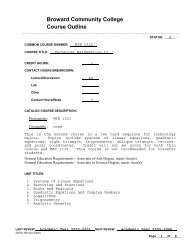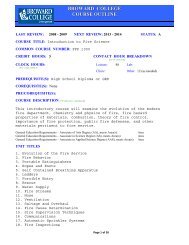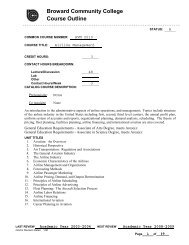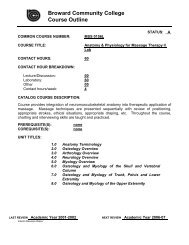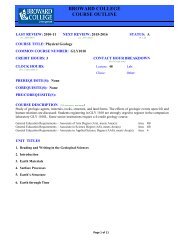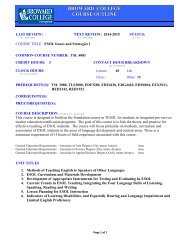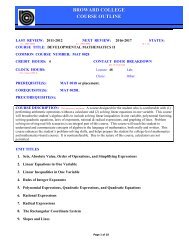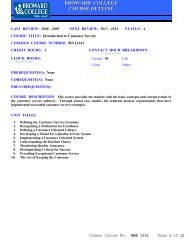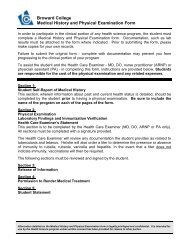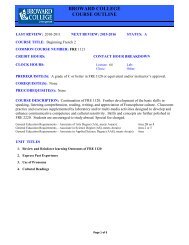CIS2321C - Broward College
CIS2321C - Broward College
CIS2321C - Broward College
Create successful ePaper yourself
Turn your PDF publications into a flip-book with our unique Google optimized e-Paper software.
BROWARD COLLEGECOURSE OUTLINELAST REVIEW: 2010-2011 NEXT REVIEW: 2015-2016 STATUS: AACOURSE TITLE: Systems Analysis and DesignCOMMON COURSE NUMBER: CIS 2321CCREDIT HOURS: 3CONTACT HOUR BREAKDOWN(per 16 week term)CLOCK HOURS: Lecture: 40 Lab: 8Clinic:Other:PREREQUISITE(S): CIS 1000C and COP 1334C (each with a grade of C or higher)COREQUISITE(S): NonePRE/COREQUISITE(S):COURSE DESCRIPTION:This course introduces the process and methodology for system analysis and design. Students willbe able to learn the process of system development, the traditional structural approach for systemanalysis and design, use of modeling tools, adherence to methodological life cycle and projectmanagement standards system development strategy and new trends of system development.Through class discussion, hands-on assignments and a team project, students will learn how totranslate business requirement into information systemsGeneral Education Requirements – Associate of Arts Degree (AA), meets Area(s):General Education Requirements – Associate in Science Degree (AS), meets Area(s):General Education Requirements – Associate in Applied Science Degree (AAS), meets Area(s):AreaAreaAreaUNIT TITLES1. Introduction to Systems Analysis and Design2. Project Initiation3. Project Management4. Requirements Determination5. Use Case Analysis6. Process Modeling7. Data Modeling8. Moving into Design9. Architecture Design10. User Interface Design11. Program DesignPage 1 of 14
BROWARD COLLEGECOURSE OUTLINEEVALUATION:Please provide a brief description (250 characters maximum) that details how students will be evaluated on the course outcomes.Evaluation instruments will include written and/or skills-based examination and individual in-class and/or take-homeassignments. Evaluation methods may also include group in-class and/or take-home assignments.**Required Competencies1) Read with critical comprehension.The student will be introduced to the basic texts, concepts, vocabulary, and methods necessary for developingan understanding of the discipline and meeting the required benchmarks as stated in the course outline.2) Write clearly and coherently.The student will demonstrate an understanding and mastery of subject matter in a variety of ways, includingwriting. Writing activities may include both graded and ungraded essays, short answer quizzes, summaries,reactions, journals, and various other reports.3) Demonstrate and apply literacy across all the disciplines (indicate which ones apply).a) Information literacy means understanding how to locate needed information, using the appropriatetechnology for the task, managing and evaluating the extracted information and using it effectively andethically.b) Technology literacy is the ability to responsibly and effectively use appropriate technology to access,manage, integrate, or create information, and/or use technology to accomplish a given task.c) Workplace literacy is having the appropriate knowledge and skills to communicate and work withothers effectively and perform job duties, whether it is through the use of computers and/or othertechnology.d) Cultural literacy is recognizing, understanding, and appreciating the similarities and differencesbetween one’s own culture and the cultures of others through a study of the arts, customs, beliefs,values, and history that define a culture.e) Quantitative literacy is having the ability to formulate, solve and interpret mathematical/statisticaloperations and graphical/tabular representations to make informed decisions.f) Scientific literacy means understanding the methodology and application of the scientific process, thephysical and biological worlds, and recognizing that scientific knowledge is continuously updated orrevised as new information is discovered.4. Apply problem-solving skills or methods to make informed decisions in a variety of contexts.The student will use acquired skills or methods to recognize, analyze, adapt, and apply criticalthinking to solve problems and make informed decisions.Page 2 of 14
BROWARD COLLEGECOURSE OUTLINEEVALUATION:In the box to the right of the Methods of Assessment, enter all specific learning outcome numbers (i.e. 1.1, 2.7, 4.0, 4.2 and 5.12) that apply.1. Portfolio2. Short essays3. Research Papers4. Group projects5. Discussions (In class and online)6. Multiple Choice tests7. Presentations8. Service Learning Projects9. Pop quizzes10. Take-home tests11. Summaries and critiques12. Reaction papers13. Surveys14. Performance15. Short answer tests16. Classroom debates and colloquia17. Blogs, wikis, web pages18. Other (Please explain)Page 3 of 14
BROWARD COLLEGECOURSE OUTLINECommon Course Number: CIS 2321CUNITSUnit 1 Introduction to Systems Analysis and DesignGeneral Outcome:1.0 The student shall:Understand the systems development life cycle, the fundamental four-phase model(planning, analysis, design, and implementation) that is common to all informationsystem development projects. Examine several commonly used system developmentmethodologies that differ in their focus and approach to each of these phases anddiscuss the skills and roles needed within a project team.Specific Measurable Learning Outcomes:Upon successful completion of this unit, the student shall be able to:1.1 Understand the fundamental systems development life cycle and its fourphases.1.2 Understand several different categories of system development methodologiesand how to choose among them.1.3 Be familiar with the different skills and roles required on a project team.Page 4 of 14
BROWARD COLLEGECOURSE OUTLINEUnit 3 Project ManagementGeneral Outcome:3.0 The student shall:Common Course Number: CIS 2321CUnderstand the basic steps of project management, from the Planning Phase throughthe Implementation Phase. Estimate the size of a project and identify the tasks andactivities that need to be performed. Develop example project managementdeliverables, including a work plan, staffing plan, and standards list.Specific Measurable Learning Outcomes:Upon successful completion of this unit, the student shall be able to:3.1 Become familiar with estimation.3.2 Create a project work plan.3.3 Understand why project teams use time boxing.3.4 Become familiar with how to staff a project.3.5 Understand how computer-aided software engineering, standards, anddocumentation improve the efficiency of a project.3.6 Understand how to reduce risk on a project.Page 6 of 14
BROWARD COLLEGECOURSE OUTLINEUnit 4. Requirements DeterminationGeneral Outcome:4.0 The student shall:Common Course Number: CIS 2321CUnderstand how, as part of the Analysis Phase, systems analysts determine thebusiness requirements for a new system. Develop a requirements definitiondocument. Comprehend how to analyze requirements through different informationgathering and business process techniques.Specific Measurable Learning Outcomes:Upon successful completion of this unit, the student shall be able to:4.1 Become familiar with the analysis phase of the SDLC.4.2 Understand how to create a requirements definition.4.3 Become familiar with requirement analysis techniques.4.4 Understand when to use each requirement analysis technique.4.5 Understand how to gather requirements using interviews, JAD sessions,questionnaires, document analysis, and observation.4.6 Understand when to use each requirement-gathering technique.Page 7 of 14
BROWARD COLLEGECOURSE OUTLINECommon Course Number: CIS 2321CUnit 5. Use Case AnalysisGeneral Outcome:5.0 The student shall:Understand how to develop Use Cases to describe key elements of requirementsdefinition. Comprehend how to, based on a Use Cases, analysts build a Process Modelfor a system.Specific Measurable Learning Outcomes:Upon successful completion of this unit, the student shall be able to:5.1 Understand the role of Use Cases.5.2 Understand the process used to create Use Cases.5.3 Be able to create Use Cases.Page 8 of 14
BROWARD COLLEGECOURSE OUTLINECommon Course Number: CIS 2321CUnit 6. Process ModelingGeneral Outcome:6.0 The student shall:Understand how a Process Model describes business processes. Create a ProcessModel by developing Data Flow Diagrams.Specific Measurable Learning Outcomes:Upon successful completion of this unit, the student shall be able to:6.1 Understand the rules and style guidelines for Data Flow Diagrams.6.2 Understand the process used to create Data Flow Diagrams.6.3 Be able to create Data Flow Diagrams.Page 9 of 14
BROWARD COLLEGECOURSE OUTLINECommon Course Number: CIS 2321CUnit 7. Data ModelingGeneral Outcome:7.0 The student shall:Understand how a Data Model describes the data that flows through the businessprocesses in an organization. Create a Data Model using Entity RelationshipDiagraming.Specific Measurable Learning Outcomes:Upon successful completion of this unit, the student shall be able to:7.1 Understand the rules and style guidelines for creating Entity RelationshipDiagrams.7.2 Be able to create an Entity Relationship Diagram.7.3 Become familiar with the data dictionary and metadata.7.4 Become familiar with the process of normalization.7.5 Understand how to balance between Entity Relationship Diagrams and DataFlow Diagrams.Page 10 of 14
BROWARD COLLEGECOURSE OUTLINECommon Course Number: CIS 2321CUnit 8. Moving into DesignGeneral Outcome:8.0 The student shall:Understand how to transition from the Analysis Phase to the Design Phase. Becomefamiliar with alternative ways to accomplish the design of a new system by creatingand evaluating an alternative matrix.Specific Measurable Learning Outcomes:Upon successful completion of this unit, the student shall be able to:8.1 Understand the initial transition from analysis to design.8.2 Understand how to create a system specification.8.3 Be familiar with alternative ways to acquire a system.8.4 Be able to create and evaluate an alternative matrix.Page 11 of 14
BROWARD COLLEGECOURSE OUTLINECommon Course Number: CIS 2321CUnit 9. Architecture DesignGeneral Outcome:9.0 The student shall:Understand how to design the architecture of a system, including its hardware,software, and network environment.Specific Measurable Learning Outcomes:Upon successful completion of this unit, the student shall be able to:9.1 Understand the fundamental components of an information system.9.2 Understand server-based, client-based, and client-server architectures.9.3 Understand how operational, performance, security, cultural and politicalrequirements affect the architecture design.9.4 Be familiar with how to create an architecture design.9.5 Be familiar with how to create a hardware and software specifications.Page 12 of 14
BROWARD COLLEGECOURSE OUTLINECommon Course Number: CIS 2321CUnit 10.User Interface DesignGeneral Outcome:10.0 The student shall:Understand the basic principles and processes of interface design and how to design asystem’s interface structure and standards.Specific Measurable Learning Outcomes:Upon successful completion of this unit, the student shall be able to:10.1 Understand fundamental user interface design principles.10.2 Understand the process of user interface design.10.3 Understand how to design the user interface structure.10.4 Understand how to design the user interface standards.10.5 Be able to design a user interface.Page 13 of 14
BROWARD COLLEGECOURSE OUTLINECommon Course Number: CIS 2321CUnit 11.Program DesignGeneral Outcome:11.0 The student shall:Understand the activities that are performed when developing a program design.Revise Logical Data Flow Diagrams and convert them into Physical Data FlowDiagrams. Use alternative techniques to communicate how the application logic for asystem needs to be developed.Specific Measurable Learning Outcomes:Upon successful completion of this unit, the student shall be able to:11.1 Be able to revise logical DFDs into physical DFDs.11.2 Be able to create a structure chart.11.3 Be able to write a program specification.11.4 Understand the use of pseudo-code.11.5 Become familiar with event-driven programmingPage 14 of 14



